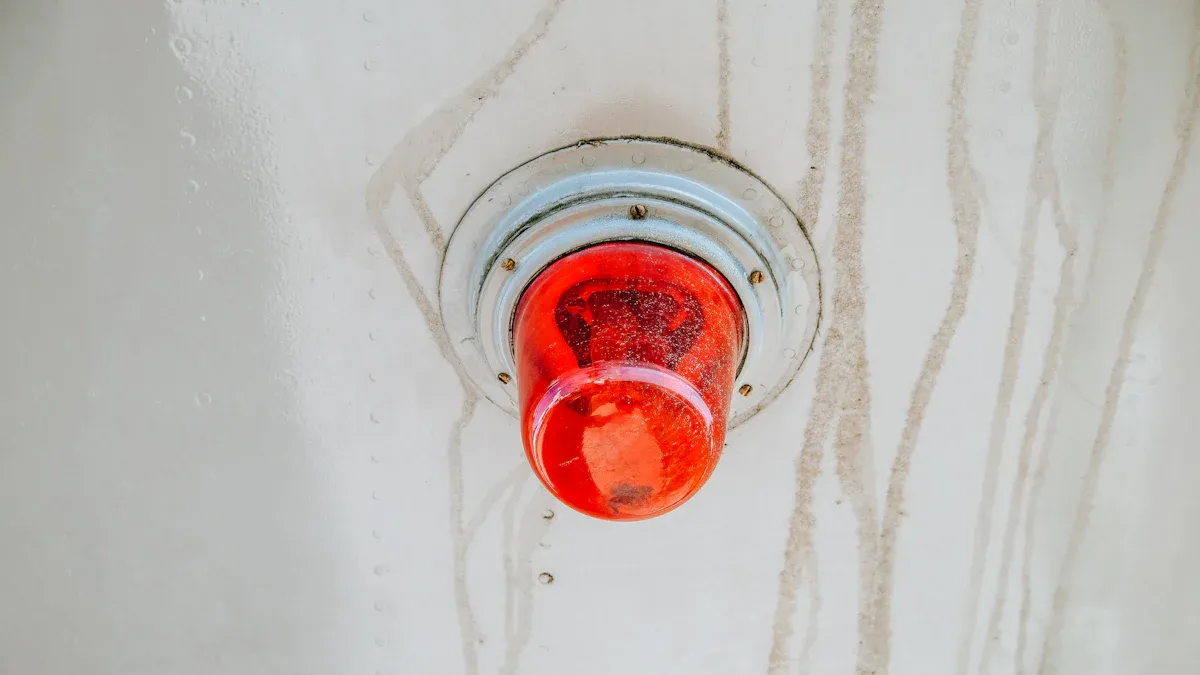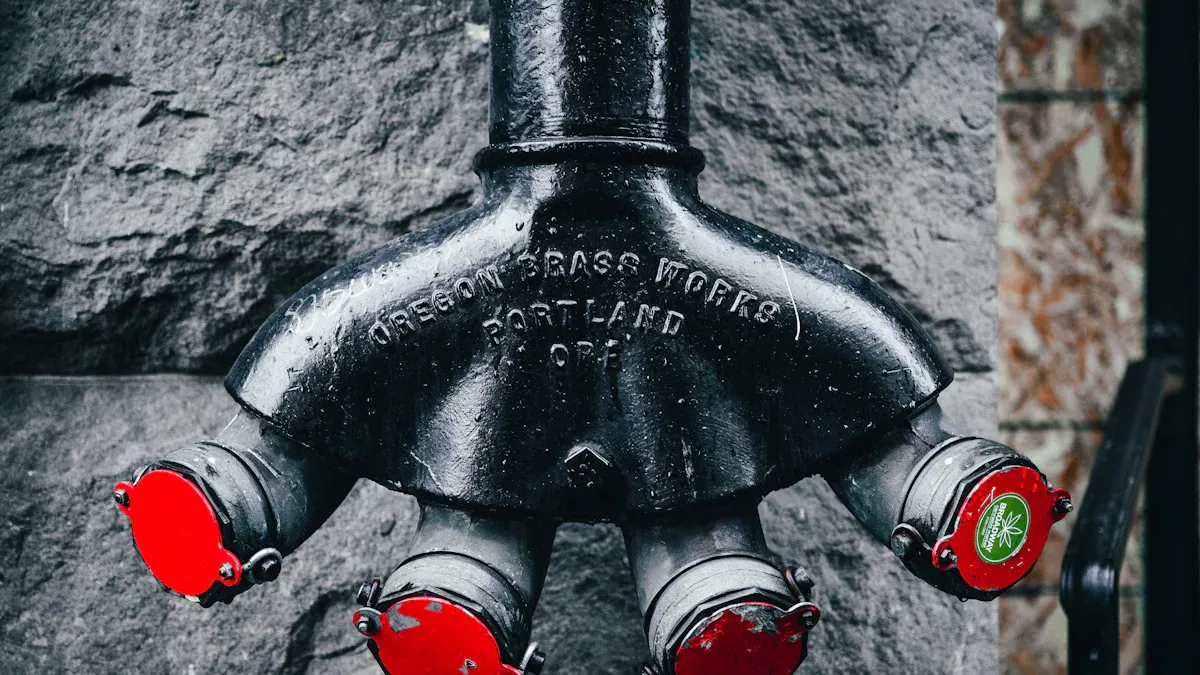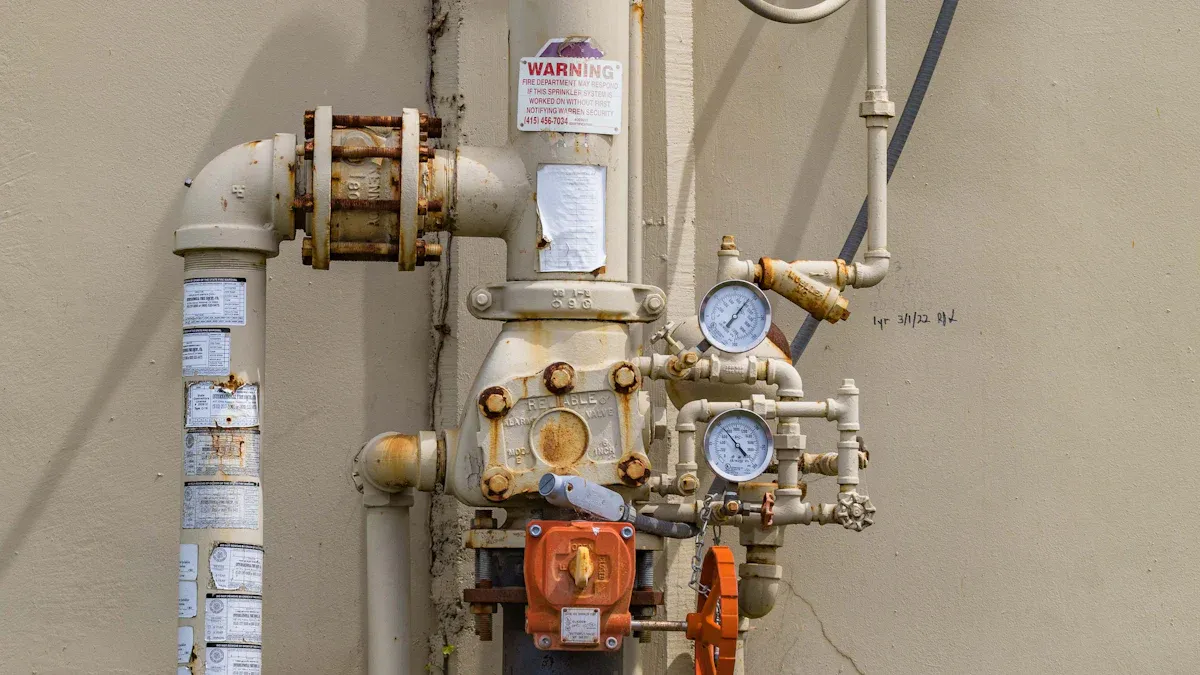
Homeowners who install a Chrome Finished Pendent Fire Sprinkler protect their homes and families. These systems control fires 90% of the time and reduce property losses by 85%. Reliable activation at 155°F and proper installation following NFPA standards ensure both safety and lasting performance.
Key Takeaways
- Choose the right sprinkler model and follow safety standards to ensure reliable fire protection and proper system performance.
- Install sprinklers carefully using the correct tools, proper torque, and approved escutcheons to prevent leaks and maintain safety certifications.
- Perform regular inspections and gentle cleaning to keep the chrome finish attractive and the system working well; call a professional if you notice damage or persistent issues.
Chrome Finished Pendent Fire Sprinkler Pre-Installation Preparation
Selecting the Right Sprinkler Model
Choosing the correct sprinkler model ensures reliable fire protection and compliance with safety codes. Homeowners should compare leading models based on features such as activation temperature, K-factor, finish, and certification. The table below highlights key differences among popular quick-response pendent sprinklers:
| Feature / Model | Viking VK3021 | Tyco TY323 | Victaulic V2708 | Reliable RA1414 |
|---|---|---|---|---|
| K-factor | 5.6 | 5.6 | 5.6 | 5.6 |
| Activation Temperatures | 135–286°F | 135–286°F | 135–286°F | 135–286°F |
| Finish Options | Brass, chrome, ENT | Brass, chrome | Brass, chrome, VC-250 | Brass, chrome, ENT |
| Approvals | FM, UL, CE | FM, UL, CE | FM, UL, CE, CCC | FM, UL, CE |
All models meet industry standards, but compactness, corrosion resistance, and escutcheon options may influence the final choice.
Gathering Tools and Materials Needed
Proper installation of a Chrome Finished Pendent Fire Sprinkler requires specific tools and materials. Installers should prepare the following:
- Sprinkler head wrenches (standard, concealed, recessed)
- Escutcheons and trim rings
- Spare head cabinets
- Guards, shields, and paint covers
- Shut off tools
- Flexible drops and risers
- Cleaning tools
Material selection also matters. Steel offers durability and familiarity, copper provides a clean finish and long lifespan, while plastic is lightweight and corrosion resistant. The 4″ flush sprinkler escutcheon in polished chrome by Viking delivers both durability and a refined appearance.
Safety Precautions Before Installation
Safety remains the top priority before starting installation. Installers must verify that the selected sprinkler model holds FM Approval and UL Listing, confirming compliance with fire protection standards. The Victaulic V2708, for example, supports up to 500 psi and uses robust materials like stainless steel and brass. Installers should always follow NFPA 13, 13R, and 13D guidelines, which address water supply, spacing, and system type. These standards ensure the system will activate at the correct temperature and provide effective coverage.
Tip: Always shut off the water supply and wear protective gear before handling any fire sprinkler components.
Chrome Finished Pendent Fire Sprinkler Installation Guide

Finding the Best Placement and Avoiding Obstructions
Proper placement of a pendent fire sprinkler ensures maximum coverage and reliable activation during a fire emergency. Installers should position each unit in the center of the ceiling or as close as possible to the recommended location in the manufacturer’s instructions. This approach allows the sprinkler to distribute water evenly across the protected area.
Obstructions such as beams, light fixtures, or HVAC vents can block the spray pattern. Installers must keep a minimum clearance of 18 inches from any object below the sprinkler. They should also avoid placing sprinklers near ceiling fans or air diffusers, as airflow can disrupt water distribution. For rooms with irregular layouts, installers may need to consult the NFPA 13 guidelines to determine the best configuration.
Tip: Mark the intended installation points before starting. This step helps prevent last-minute adjustments and ensures compliance with spacing requirements.
Installing with Proper Torque and Escutcheon Use
Correct installation techniques protect both the sprinkler and the home. Installers must use the manufacturer-approved wrench to tighten the sprinkler head. Over-tightening can damage the threads or internal components, while under-tightening may cause leaks. The maximum tightening torque for 1/2-inch NPT threads is 14 ft-lb (19 N-m). Installers should never exceed this limit.
The escutcheon, a trim ring that covers the gap between the sprinkler and the ceiling, plays a critical role. Only approved escutcheons, such as Viking E-1, E-2, or E-3, should be used. These accessories help maintain the fire rating of the ceiling and provide a finished appearance. The use of listed escutcheons also supports compliance with multiple certifications, including cULus, FM, and CE.
- Use only the specified installation wrench for the sprinkler model.
- Tighten to the recommended torque—never more than 14 ft-lb.
- Install the escutcheon flush with the ceiling for a secure fit.
Note: Manufacturer’s instructions and listing approvals confirm that proper torque and escutcheon use meet recognized technical standards.
Achieving a Secure, Leak-Free Fit
A secure, leak-free fit ensures the Chrome Finished Pendent Fire Sprinkler will function as designed. Installers should wrap the sprinkler threads with Teflon tape or pipe sealant approved for fire protection systems. This step prevents water leaks and protects the ceiling from moisture damage.
After threading the sprinkler into the fitting, installers should check alignment and ensure the escutcheon sits flush against the ceiling. Any visible gaps or misalignment can compromise both appearance and performance. Once installed, the system should be pressurized and inspected for leaks at the connection points.
- Inspect the installation visually for gaps or crooked alignment.
- Pressurize the system and check for drips or moisture around the sprinkler.
- If leaks appear, depressurize, remove, and reinstall the sprinkler using fresh sealant.
Callout: Never use excessive force or substitute tools during installation. Doing so can void certifications and damage the sprinkler.
Chrome Finished Pendent Fire Sprinkler Initial Testing and Inspection
Checking for Leaks and Proper Water Flow
After installation, homeowners should check for leaks and confirm proper water flow. They can slowly open the water supply valve and observe the sprinkler head and surrounding area. Any sign of dripping or moisture indicates a leak. Homeowners should also listen for unusual sounds in the pipes, which may signal trapped air or loose fittings.
A simple checklist helps during this process:
- Inspect the sprinkler head and escutcheon for visible leaks.
- Feel the ceiling area for dampness.
- Watch for steady water flow from the test valve.
Tip: Use a dry paper towel to detect small leaks around the sprinkler base.
Verifying Operation and Spray Coverage
Homeowners should verify that the sprinkler operates as intended. They can activate the test valve to simulate system operation. Water should spray in a uniform, circular pattern, covering the designated area. If the spray appears uneven or blocked, an obstruction may exist.
A table can help track spray coverage:
| Test Location | Coverage Satisfactory? | Notes |
|---|---|---|
| Living Room | Yes | No obstructions |
| Bedroom | No | Adjust needed |
Troubleshooting Common Installation Issues
Common issues include leaks, misaligned heads, or poor spray patterns. Homeowners should:
- Re-tighten fittings if leaks persist.
- Adjust the escutcheon for a flush fit.
- Remove any nearby objects blocking the spray.
Note: If problems continue, consult a licensed fire protection professional.
Chrome Finished Pendent Fire Sprinkler Routine Maintenance

Safe Cleaning Methods for Chrome Finish
Routine cleaning preserves the appearance and function of a chrome finish. Homeowners should avoid abrasive materials and harsh chemicals. Soft microfiber cloths remove dust and fingerprints without scratching the surface. For stubborn spots, a solution of mild dish soap and warm water works well.
A simple cleaning process includes:
- Dampen a microfiber cloth with soapy water.
- Gently wipe the chrome surface.
- Rinse the cloth with clean water and wipe again.
- Dry the area with a soft, dry towel.
Tip: Never use steel wool, scouring pads, or ammonia-based cleaners. These products can scratch or dull the chrome finish.
Regular cleaning prevents buildup and keeps the Chrome Finished Pendent Fire Sprinkler looking new.
Preventing Corrosion, Tarnish, and Blockages
Corrosion and tarnish can reduce the effectiveness of fire sprinklers. Moisture, dust, and airborne contaminants often cause these issues. Homeowners should inspect the sprinkler heads monthly for signs of discoloration or residue. If they notice any green or brown spots, they should clean the area immediately.
To prevent blockages, homeowners should keep the area around the sprinkler free from dust and cobwebs. They should never hang objects from the sprinkler or cover it with decorations.
A maintenance checklist helps prevent problems:
| Task | Frequency | Notes |
|---|---|---|
| Visual inspection | Monthly | Look for corrosion or debris |
| Light cleaning | Monthly | Use soft cloth only |
| Deep cleaning (if needed) | Every 6 months | Avoid harsh chemicals |
Note: If corrosion or blockage persists after cleaning, a professional should inspect the system.
Inspecting for Damage and System Function
Regular inspections ensure the fire sprinkler system remains reliable. Homeowners should look for bent, cracked, or missing parts. They should also check that the escutcheon sits flush with the ceiling and that no leaks appear around the sprinkler head.
A step-by-step inspection process includes:
- Examine the sprinkler head for physical damage.
- Check the escutcheon for gaps or misalignment.
- Test the system’s water flow using the test valve.
- Listen for unusual sounds during operation.
If any part appears damaged or the system does not function as expected, homeowners should contact a certified technician. Early detection of issues prevents costly repairs and ensures the Chrome Finished Pendent Fire Sprinkler operates during an emergency.
Callout: Never paint or tamper with the sprinkler head. Altering the device can void warranties and compromise safety.
Chrome Finished Pendent Fire Sprinkler Do’s and Don’ts
What to Avoid When Cleaning or Handling
Homeowners should never paint fire sprinkler heads after installation. Aftermarket painting can damage sensitive components and prevent proper operation. Only manufacturer-applied coatings provide the necessary corrosion resistance and maintain the sprinkler’s reliability. Using abrasive pads, steel wool, or harsh chemicals can scratch or dull the chrome finish. These actions may also compromise the sprinkler’s ability to activate during a fire.
Avoid hanging decorations, clothing, or any objects from the sprinkler head. Even light pressure can damage the internal mechanism or misalign the escutcheon. Never use substitute tools or excessive force when installing or cleaning. Improper handling can void certifications and reduce the effectiveness of the system.
Tip: Always use a soft microfiber cloth and mild soap for cleaning. Keep the area around the sprinkler clear of obstructions.
Best Practices for Preserving Finish and Performance
Selecting sprinklers with proper listings and approvals, such as UL or FM Global, ensures suitability for the intended environment. In areas with high humidity or corrosive conditions, use manufacturer-approved corrosion-resistant coatings that comply with NFPA 13 standards. Homeowners should always install the correct escutcheon, sized for the sprinkler’s orifice and approved for the specific model. Proper escutcheon use prevents heat from bypassing the sprinkler head and ensures timely activation.
Die-cast frames offer a smooth, even surface, which benefits the chrome finish and simplifies cleaning. For improved aesthetics and easier maintenance, consider flush or concealed pendent sprinklers. Regular inspections and gentle cleaning help maintain both appearance and function.
Note: Consistent care and adherence to manufacturer guidelines extend the life and reliability of the fire sprinkler system.
When to Call a Professional for Chrome Finished Pendent Fire Sprinkler Care
Recognizing Signs of Malfunction
Homeowners should stay alert for warning signs that indicate a fire sprinkler system may not function correctly. Water stains or persistent dampness around the sprinkler head often signal a hidden leak. Corrosion, discoloration, or mineral buildup on the chrome surface can also point to internal issues. If a sprinkler head appears bent, cracked, or misaligned, it may not activate during a fire. Unusual noises, such as banging or hissing from the pipes, suggest trapped air or pressure problems. A sudden drop in water pressure during a test can reveal a blockage or valve failure.
Tip: Homeowners should document any changes or irregularities and share this information with a licensed technician.
Addressing Complex Maintenance or Replacement Needs
Some maintenance tasks require specialized knowledge and tools. If a homeowner discovers a damaged or corroded sprinkler head, only a certified professional should replace it. Professionals can also inspect for hidden leaks inside walls or ceilings. They use advanced equipment to test system pressure and flow rates. When a system fails to pass a routine inspection, a technician can diagnose the root cause and recommend repairs. Upgrading or expanding a fire sprinkler system involves code compliance and precise installation. Homeowners should never attempt these tasks alone.
A table helps clarify when to call a professional:
| Situation | Professional Needed? |
|---|---|
| Minor cleaning | No |
| Visible damage or corrosion | Yes |
| System fails inspection | Yes |
| Upgrading or replacing components | Yes |
- Regular inspection and gentle cleaning keep a Chrome Finished Pendent Fire Sprinkler reliable and attractive.
- Homeowners who stay proactive help ensure safety and preserve the system’s appearance.
- When uncertain about maintenance or repairs, they should always contact a qualified professional.
FAQ
How often should a homeowner inspect chrome finished pendent fire sprinklers?
Homeowners should inspect each sprinkler monthly. Regular checks help identify corrosion, leaks, or obstructions early.
Tip: Set a recurring reminder for monthly inspections.
Can a homeowner paint or decorate a chrome finished pendent fire sprinkler?
No, painting or decorating the sprinkler can block activation and void warranties.
Only manufacturer-applied finishes protect the device and ensure proper function.
What should a homeowner do if a sprinkler head appears damaged?
They should contact a licensed fire protection professional immediately.
- Never attempt repairs or replacements without proper training.
- Safety depends on expert assessment.
Post time: Jun-29-2025
